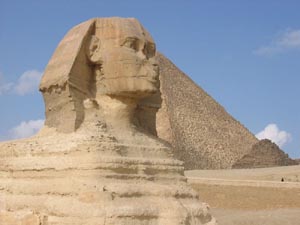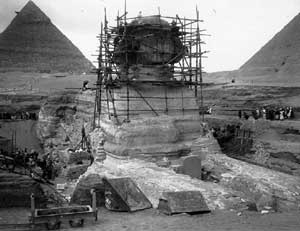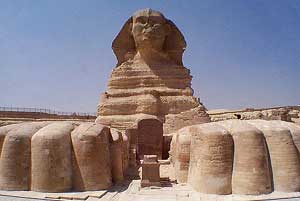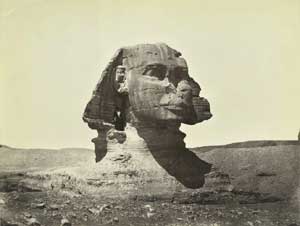Great Sphinx of Giza
 |
|
The Great Sphinx at Giza, Egypt |
The Great Sphinx of Giza is a large half-human, half-lion
Sphinx statue in Egypt, on the Giza Plateau at the west bank
of the Nile River, near modern-day Cairo (29.975299° N 31.137496°
E). It is one of the largest single-stone statues on Earth,
and is commonly believed to have been built by ancient Egyptians
in the 3rd millennium BC.
What name ancient Egyptians called the statue is
not completely known. The commonly used name “Sphinx” was
given to it in Antiquity based on the legendary Greek creature
with the body of a lion, the head of a woman and the wings
of an eagle, though Egyptian sphinxes have the head of a man.
The word “sphinx” comes from the Greek Sphinx, apparently
from the verb sphingo, meaning “to strangle,” as the sphinx
from Greek mythology strangled anyone incapable of answering
her riddle. A few, however, have postulated it to be a corruption
of the ancient Egyptian Shesep-ankh, a name applied to royal
statues in the Fourth Dynasty, though it came to be more specifically
associated with the Great Sphinx in the New Kingdom. In medieval
texts, the names balhib and bilhaw referring to the Sphinx
are attested, including by Egyptian historian Maqrizi, which
suggest Coptic constructions, but the Egyptian Arabic name
Abul-Hôl, which translates as “Father of Terror,” came to
be more widely used.
 |
|
The Great Sphinx on December 26, 1925, undergoing restoration. |
Description
The Great Sphinx is a statue with the face of a man
and the body of a lion. Carved out of the surrounding limestone
bedrock, it is 57 metres (260 feet) long, 6 m (20 ft) wide,
and has a height of 20 m (65 ft), making it the largest single-stone
statue in the world. Blocks of stone weighing upwards of 200
tons were quarried in the construction phase to build the
adjoining Sphinx Temple. It is located on the west bank of
the Nile River within the confines of the Giza pyramid field.
The Great Sphinx faces due east, with a small temple between
its paws.
Restoration
After the Giza Necropolis was abandoned, the Sphinx
became buried up to its shoulders in sand. The first attempt
to dig it out dates back to 1400 BC, when the young Tutmosis
IV formed an excavation party which, after much effort,
managed to dig the front paws out. Tutmosis IV had a granite
stela known as the Dream Stela placed between the paws. The
stela reads, in part:
 |
| Notice
the stela in the small
temple between its paws. |
...the royal son, Thothmos, having been arrived,
while walking at midday and seating himself under the shadow
of this mighty god, was overcome by slumber and slept at the
very moment when Ra is at the summit (of heaven). He found
that the Majesty of this august god spoke to him with his
own mouth, as a father speaks to his son, saying: Look upon
me, contemplate me, O my son Thothmos; I am thy father, Harmakhis-Khopri-Ra-Tum;
I bestow upon thee the sovereignty over my domain, the supremacy
over the living ... Behold my actual condition that thou mayest
protect all my perfect limbs. The sand of the desert whereon
I am laid has covered me. Save me, causing all that is in
my heart to be executed.
Ramesses II may have also performed restoration work
on the Sphinx.
It was in 1817 that the first modern dig, supervised
by Captain Caviglia, uncovered the Sphinx’s chest completely.
The entirety of the Sphinx was finally dug out in 1925.
 |
|
The Great
Sphinx in 1867.
Note its unrestored original condition
and the man standing beneath its ear. |
Missing Nose
The one-meter-wide nose on the face is missing. A
legend that the nose was broken off by a cannon ball fired
by Napoléon’s soldiers still survives, as do diverse variants
indicting British troops, Mamluks, and others. However, sketches
of the Sphinx by Frederick Lewis Norden made in 1737 and published
in 1755 illustrate the Sphinx without a nose. The Egyptian
historian al-Maqrizi, writing in the fifteenth century, attributes
the vandalism to Muhammad Sa'im al-Dahr, a Sufi fanatic from
the khanqah of Sa'id al-Su'ada. In 1378, upon finding the
Egyptian peasants making offerings to the Sphinx in the hope
of increasing their harvest, Sa'im al-Dahr was so outraged
that he destroyed the nose. Al-Maqrizi describes the Sphinx
as the “Nile talisman” on which the locals believed the cycle
of inundation depended.
Curious and droll fictional explanations of the nose’s
disappearance occasionally appear in modern entertainment
set in vaguely appropriate times, such as in Asterix and Cleopatra.
In addition to the lost nose, a ceremonial pharaonic
beard is thought to have been attached, although this may
have been added in later periods after the original construction.
Egyptologist Rainer Stadelmann has posited that the rounded
divine beard may not have existed in the Old or Middle Kingdoms,
only being conceived of in the New Kingdom to identify the
Sphinx with the god Horemakhet. This may also relate to the
later fashion of pharaohs, which was to wear a plaited beard
of authority—a false beard (chin straps are actually visible
on some statues), since Egyptian culture mandated that men
be clean shaven. Pieces of this beard are today kept in the
British Museum and the Egyptian Museum.
Mythology
The Great Sphinx was believed to stand as a guardian
of the Giza Plateau, where it faces the rising sun. It was
the focus of solar worship in the Old Kingdom, centered in
the adjoining temples built around the time of its probable
construction. Its animal form, the lion, has long been a symbol
associated with the sun in ancient Near Eastern civilizations.
Images depicting the Egyptian king in the form of a lion smiting
his enemies appear as far back as the Early Dynastic Period
of Egypt. During the New Kingdom, the Sphinx became more specifically
associated with the god Hor-em-akhet (Greek Harmachis) or
Horus at the Horizon, which represented the Pharaoh in his
role as the Shesep ankh of Atum (living image of Atum). A
temple was built to the northeast of the Sphinx by King Amenhotep
II, nearly a thousand years after its construction, dedicated
to the cult of Horemakhet.